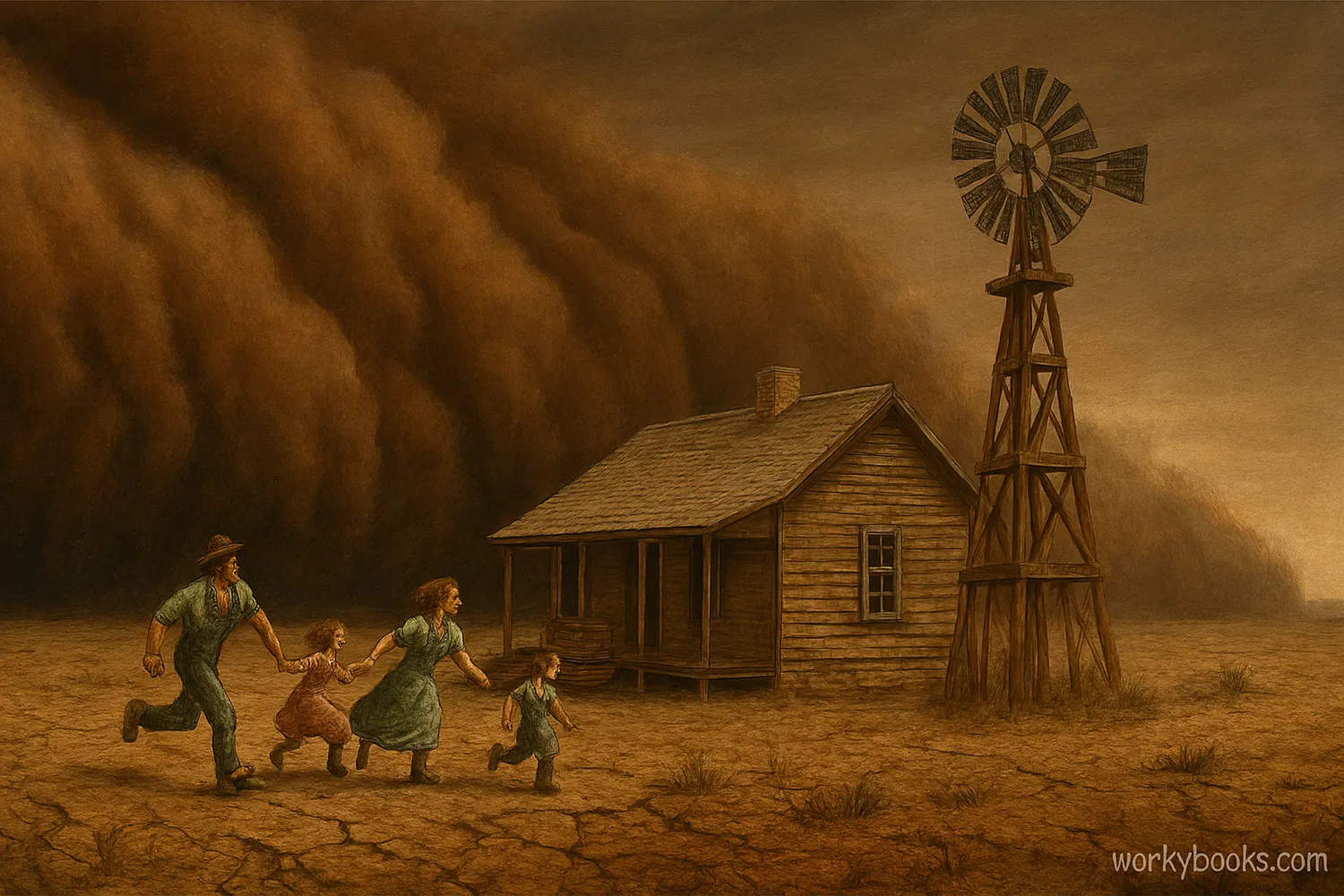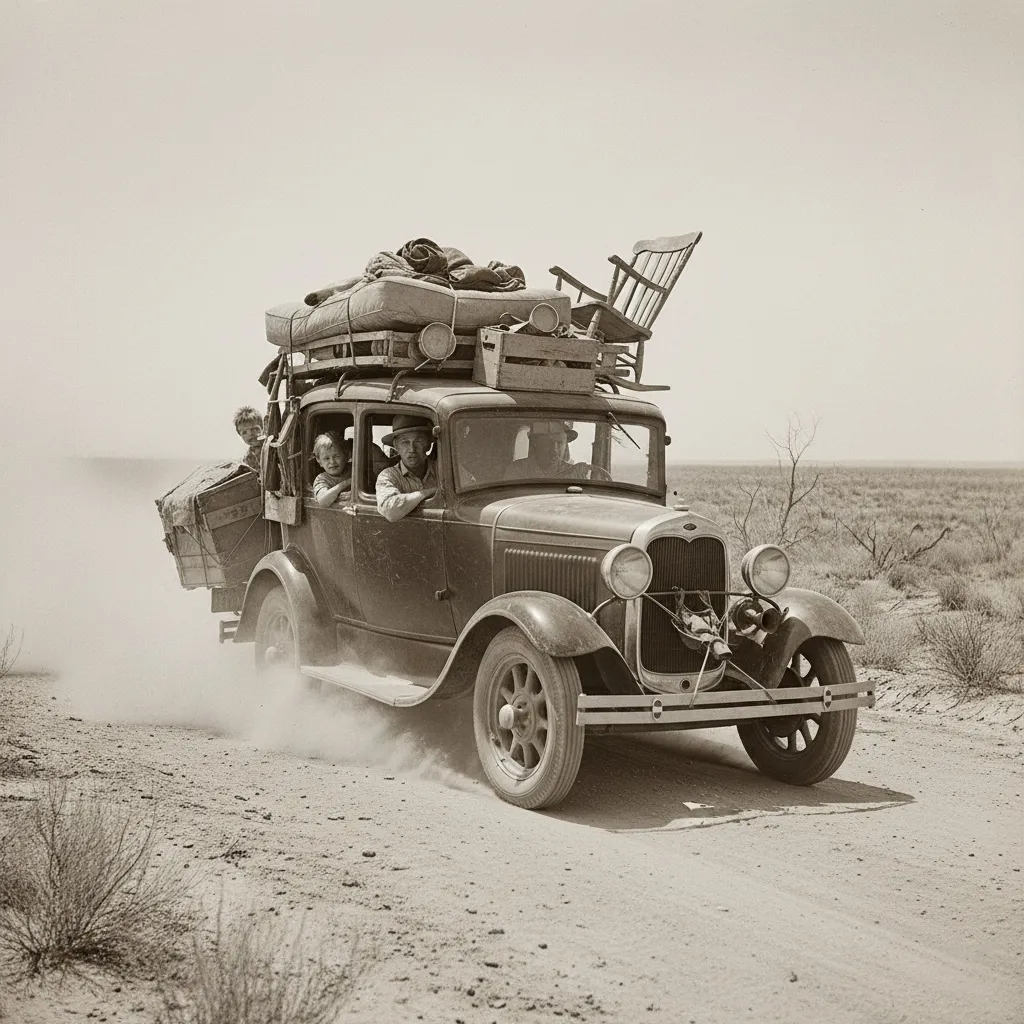Dust Bowl
Learn about the Dust Bowl during the Great Depression, its causes, effects, and the migration it caused
What Was the Dust Bowl?

The Dust Bowl was a period of severe dust storms that greatly damaged the ecology and agriculture of the American and Canadian prairies during the 1930s. The phenomenon was caused by a combination of severe drought and poor farming practices.
The Dust Bowl affected parts of Oklahoma, Texas, Kansas, Colorado, and New Mexico. It forced many families to abandon their farms and migrate to other areas, especially California. This difficult time coincided with the Great Depression, making life even harder for millions of Americans.
Did You Know?
The Dust Bowl got its name from a newspaper reporter who first used the term after witnessing one of the massive dust storms in 1935.
Causes of the Dust Bowl

Several factors combined to create the Dust Bowl:
Drought
Severe lack of rainfall for several years dried out the soil
Poor Farming
Deep plowing removed native grasses that held soil in place
High Winds
Strong winds picked up the dry, loose soil creating dust storms
Farmers had removed the deep-rooted native grasses that normally trapped soil and moisture. When the drought came, the bare, over-plowed farmland had no protection from the wind. The topsoil simply blew away, creating massive dust storms called "black blizzards."
Black Sunday

Black Sunday refers to April 14, 1935, when one of the worst dust storms in American history swept across the Great Plains. The storm was so massive and dark that some people thought it was the end of the world.
The Black Sunday dust storm was hundreds of miles wide and traveled at speeds of up to 100 miles per hour. It carried an estimated 300,000 tons of topsoil, darkening skies from the Great Plains all the way to the East Coast.
Eyewitness Account
"The storm was like a black wall that reached the sky. It was the most terrifying thing I ever saw. We thought it was Judgment Day." - Dust Bowl survivor
The Great Migration

As conditions worsened, many families had no choice but to leave their homes. About 2.5 million people left the Dust Bowl states during the 1930s. Many headed to California hoping to find work as farm laborers.
These migrants were often called "Okies" because many came from Oklahoma, though they actually came from several affected states. They faced difficult journeys and often encountered hostility when they arrived in California, where jobs were scarce.
Drought Begins
Severe drought starts affecting the Great Plains region
Mass Migration
Thousands of families begin leaving the Dust Bowl states
Black Sunday
Worst dust storm of the era hits on April 14
Rain Returns
Regular rainfall finally returns to the Great Plains
Impact and Legacy

The Dust Bowl had lasting effects on American society and the environment:
Soil Conservation
New farming methods were developed to prevent soil erosion
Shelterbelts
Government planted trees to act as windbreaks across the plains
Cultural Impact
Inspired books like "The Grapes of Wrath" by John Steinbeck
The U.S. government created the Soil Conservation Service (now Natural Resources Conservation Service) to teach farmers better land management practices. These included contour plowing, crop rotation, and planting trees as windbreaks. These changes helped prevent another Dust Bowl from happening.
Dust Bowl Quiz
Test your knowledge about the Dust Bowl! Answer all 5 questions to see how much you've learned.
Frequently Asked Questions
Here are answers to common questions about the Dust Bowl:
Dust Bowl Trivia
Discover interesting facts about the Dust Bowl!
Dust Storms
Some dust storms during the Dust Bowl were so large that they carried dust all the way to Washington D.C. and even out over the Atlantic Ocean.
Mass Migration
About 2.5 million people left the Dust Bowl states during the 1930s. Many traveled along Route 66 to California in search of work.
Soil Loss
During the Dust Bowl, an estimated 850 million tons of topsoil blew away in 1935 alone. That's enough soil to cover the entire state of Connecticut 4 inches deep!
Cultural Impact
Woody Guthrie, a famous folk singer, wrote many songs about the Dust Bowl and the experiences of migrant workers, including "This Land Is Your Land."


